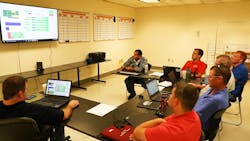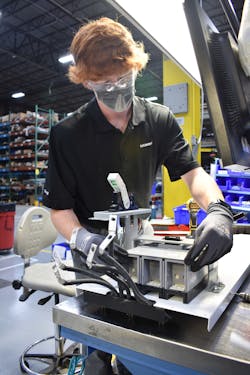It’s no secret that the manufacturing and processing industries continue to face a growing skills gap. Deloitte predicts that 4.6 million manufacturing jobs will be created over the next decade and as many as 2.4 million of those positions are likely to remain unfilled. This challenge is exacerbated by the rapid pace of technological change.
The abundance of open jobs in the manufacturing industries is not merely due to a lack of labor in the quantitative sense. New workers, even when available, are increasingly required to possess a set of abilities that differ from those needed in the past. Previously, skilled manufacturing employees would have needed knowledge of application or machine-specific processes. Today, the qualifications have become much more complex.
“Once upon a time, workers had tribal knowledge. They knew individual machines, programmable logic controller (PLC) design and programming, sensors, wiring, and so on. It was a very specific skillset that centered around particular elements of a process or machine,” says Ben Orchard, senior application engineer at Opto 22. “Think about a bottling plant. It’s very high speed, and if something goes wrong, there’s a lot of breakage and a lot of downtime. As a result, everything is done to keep that machine or process running. A worker’s skills would be very fine-tuned around that exact aspect of production.”
Moreover, these machines and processes ran predominantly on proprietary systems. When data was extracted, it was rudimentary in nature and only historicized for display on localized human machine interfaces (HMIs) that provided operations and maintenance personnel with insights into that machine or line. By contrast, data is now widely extracted from an array of assets and must be formatted in such a way that it can be sent to higher-level—sometimes external—systems and integrated with other data sets effectively.
“Customers now want all of their data brought in… [which] presents challenges to the way we used to do things,” says Travis Cox, co-director of sales engineering at Inductive Automation. “The protocols and architecture have completely changed these days from what they used to be. We now have to leverage many new technologies from the IT space, such as MQTT (message queueing telemetry transport), SQL databases, and APIs (application programming interfaces). We need a more comprehensive skillset than in the past. Workers have to be able to not only build the operational piece of a system, but also figure out how that integrates with everything else.”
Most of the advanced skills required for digital transformation pertain to IT. Because of this, more workers entering the manufacturing industries will be required to hold four-year university degrees in topics such as mathematics or computer science. Fortunately, there is no shortage of available college graduates with these degrees. However, it is difficult to find candidates among them who want to apply their skills in the manufacturing industries.
The reasons for this are two-fold. On one hand, a general lack of enthusiasm for manufacturing among young people makes it less likely that it is their first choice for a career. In addition, applying data analytics, programming, and software skills in a real-time manufacturing environment can be significantly different than doing so in other fields, even if the core methodologies being used are the same.
“The comparison I often like to use to make the point is that YouTube buffers. If someone is watching a video, the network can go down for a couple of seconds and the video doesn’t stop. Those couple of seconds of network outage on a manufacturing process can result in collisions, things breaking, or an entire factory stopping,” Orchard says. “Without practical knowledge of the equipment, IT guys don’t understand that there is a significant difference between starting a pump now and starting that same pump 10 seconds later.”
Furthermore, it may be difficult for data analysts and programmers to determine which pieces of data produced by machines are relevant if they do not understand the operations of individual processes and pieces of equipment. While university courses can teach students how to input data into an SQL database, it cannot teach them which data to select. At the end of the day, only specific, hands-on experience can really suffice to properly educate employees.
“Having hands-on experiences, being in the environment, learning the lingo, and understanding how people solve problems within a given field is simply something that can’t be taught in a classroom,” says Terry Orchard, a recent college graduate who now holds the role of technical marketing specialist at Opto 22.
Given these realities, more and more industrial companies are realizing they need to pursue operations technology (OT) training and education initiatives with the same fervor as they pursue those for IT.
OT knowledge needs to be maintained not only to assist IT staff in more effectively making use of data, but also to make sure fundamental, day-to-day operations such as maintenance can continue being carried out on legacy assets. This is particularly important for companies engaging in incremental automation updates rather than a wholesale replacement of assets, since they will need to service a mixture of old and new equipment.
According to Cox, the looming OT skills gap is actually a more severe issue than the IT skills gap in many ways, as there is a genuine lack of applicants, and less attention is being paid to the problem. With many baby boomers nearing retirement, it could result in substantial business disruptions in the future.
“A lot of the people who really understand the OT side of the fence are retiring. If companies don’t address that now, they could have a real problem trying to do so later. The new folks that are coming in, while they might understand IT and newer technologies, are still going to need to design solutions that work for the operations folks, and we’re still going to have to be able to keep that OT equipment running,” Cox says. “Companies that are investing in new technologies also need a plan to get the old stuff into a newer framework. Otherwise, they’re going to have a huge gap later on where, if something breaks, they’re not going to be able to fix it. If these companies don’t pay attention now, they’re going to get to a place where they have a lot of downtime and have to spend a lot of money.”
While much of digital transformation is ultimately about bridging the IT/OT divide, there are still distinctive training issues to be solved in each space. Regarding IT, there are plentiful college graduates available, but more needs to be done to prepare them to apply their skillsets to a manufacturing environment. On the OT front, there is the overall lack of available talent that Cox mentioned, on top of the difficulty involved in capturing legacy knowledge as older workers retire.
To fix the IT skills gap in manufacturing, more internships and apprenticeship-style learning need to be promoted as a compliment to classroom education. According to Ben and Terry Orchard, this will require cultural changes, as well as an institutional shift, since many current college students studying IT-related fields do not see manufacturing as their ideal career path.
Students should also be encouraged to pursue independent learning and side projects that position them to work manufacturing industry sectors. With the growth of open-source communities and online platforms such as Github, it has become common for students pursuing IT-related careers to bolster their resumes with extracurricular work of this nature. Because the skills required to work in manufacturing vary depending on the specific industry sector one seeks to enter, this aspect of industry could be marketed to students by manufacturers as a means of providing students with a competitive advantage in the job market.
Bridging the OT skills gap will require a slightly different approach. According to Amanda Beaton, program manager for U.S. Cooperates with Education, an outreach program created by Siemens, more vocational education programs must be created from the ground up. To do this, Beaton recommends public-private partnerships, in which local and state governments provide grant funding and private corporations donate equipment for students to train on. Developing training programs this way ensures that the financial burden is well-distributed among all stakeholders, and that students come away with hands-on knowledge of the equipment they will be working on in the field. In fact, Beaton says she’s never seen a vocational education program succeed that wasn’t developed with input from the academic institution, government, and the private sector in tandem.
Most importantly, because the lack of available talent is more severe in the OT domain, companies must begin by generating more enthusiasm, not only at the post-secondary, but also at the primary and secondary levels.
“You’re almost hitting it too late once you go to the post-secondary or college level. The first thing is instilling excitement and inciting interest for middle and high school students for these middle skill careers and skilled trades,” Beaton says. “As a country, the U.S. placed so much value on four-year degrees that we’ve created a significant skills gap. We have to not only instill excitement in students about these careers, but also [involve] the parents who may not envision their children going into a skilled trade. There’s a lot of work to be done on this perception issue.”
About the Author
David Miller
Former Senior Technical Writer

Leaders relevant to this article:



